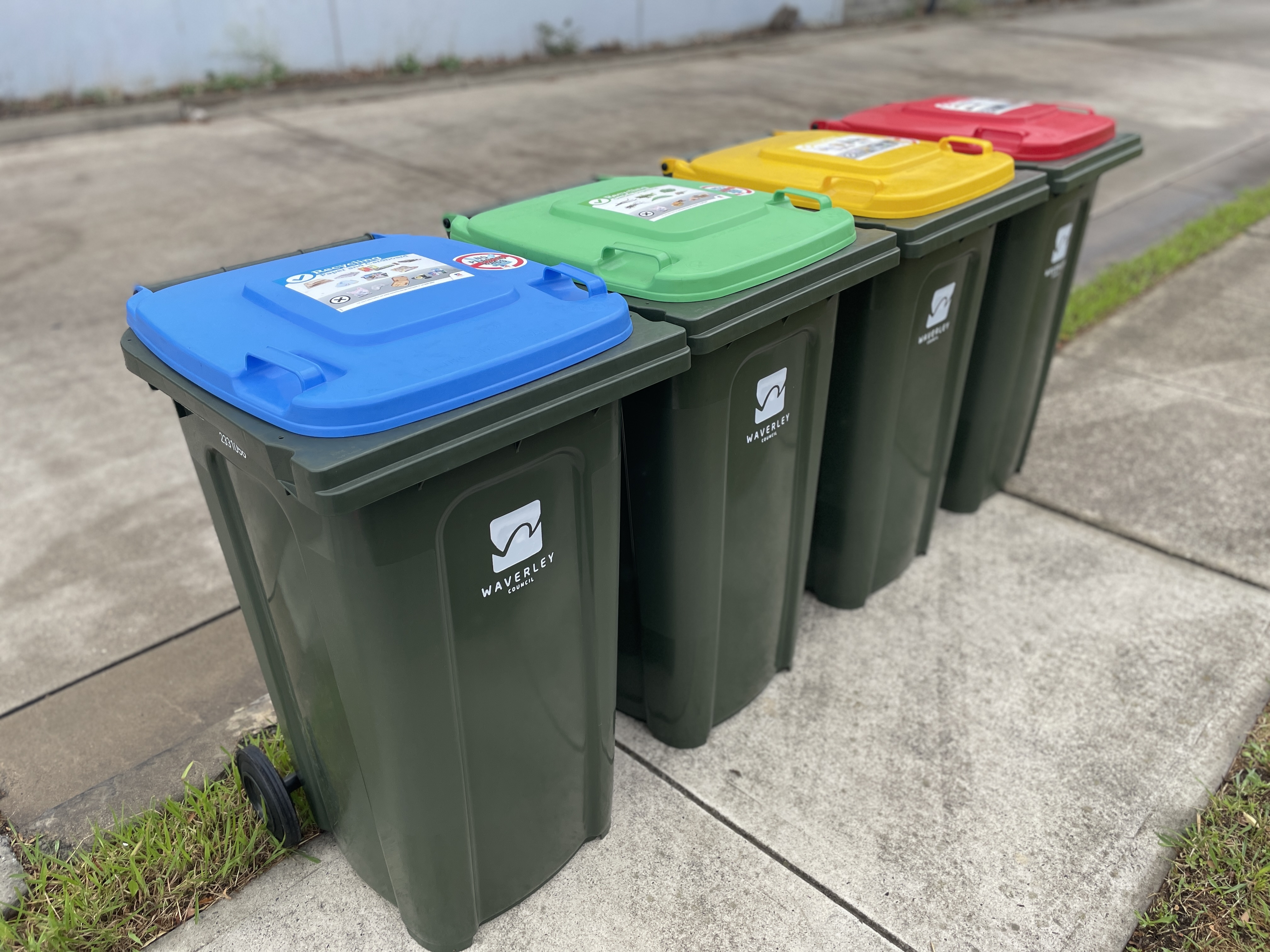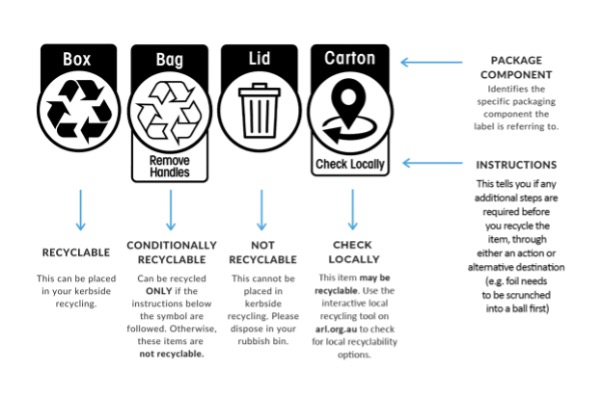Bins & collection days
Waverley residents have access to a range of waste and recycling services, including:
- weekly garbage collection
- fortnightly recycling collection of household containers and paper
- fortnightly garden organics collection
- clean-up collection for bulky household items
- free collection of good quality household goods via The Bower Reuse & Repair Centres

Find your collection days
Find your bin collection day and your scheduled clean-up collection date here.
Sort your waste correctly
Help us recycle better by putting your items in the right bin.
For the waste that cannot go in kerbside bins, there are often multiple ways to recycle or dispose of the item responsibly and locally. Consult our A-Z Waste & Recycling Directory.
Waste that is beside bins or overflowing from the bin top can create litter and will not be collected.
The downloadable guide “Recycling right in Waverley: A guide to help residents recycle more” is also available.
This bin is for items that cannot be recycled with most of the contents of red bins going to landfill.
For the safety of our staff, never dispose of any batteries in your household bins.
Use your garbage bin for:
- soft plastics (any plastic that can be scrunched)
- food scraps (or even better, get a discounted compost bin)
- nappies, wipes and sanitary products
- paper towels, serviettes and tissues
- broken crockery (wrap your items before placing them in the bin)
- bagged dust
- bamboo and wooden cutlery
- pet waste and cat litter
- take-away coffee cups
- foil-lined long-life cartons (e.g Tetra Pak)
Do not use your garbage bin for:
- construction and demolition waste
- commercial and business waste
- hazardous materials (gas bottles, chemicals, solvents, paints and oils)
- sharps
- household and car batteries
- electronic waste
If there is an item you’re not sure how to dispose of, review our A-Z Waste & Recycling Directory.
The contents of the garbage bins collected by Waverley Council are processed at Veolia Woodlawn.
Follow three simple steps to recycle right:
- Check the Australasian Recycling Label (ARL) symbols in your container to find out if the container can be recycled in the yellow or blue bin (the numbered plastic symbols do not mean an item is recyclable, so use the ARL symbols as the primary guide)
- Empty containers and rinse them before disposal (containers should have no food or liquid residue)
- Place recyclables loosely in the bin (bagged recycling cannot be recycled). If you live in an apartment, you can order one of our free recycling bags to help transport your items to the bin room.
Use your container recycling bin for:
- aluminium and steel cans
- glass bottles and jars (lids on)
- plastic bottles (lids on)
- biscuit trays and single-use plastic containers, including takeaway containers (no food scraps)
- aerosol cans (empty)
- clean aluminium foil (scrunch into a fist sized ball) and trays
Do not use your container recycling bin for:
- soft plastics (plastic that can be scrunched), such as bread and frozen vegetable bags
- takeaway coffee cups
- foil-lined long-life cartons (e.g Tetra Pak)
- polystyrene
- crockery, ceramics and porcelain
- non-recyclable glass (e.g. windows, mirrors or drinking glasses)
- gas bottles
- light globes
If there is an item you’re not sure how to dispose of, review our A-Z Waste & Recycling Directory.
The contents of container recycling bins collected by Waverley Council are processed at Visy Smithfield.

Image courtesy of Planet Ark
Most paper and cardboard is recyclable as long as it’s clean and dry.
Use your paper & cardboard bin for:
- office paper, newspapers, magazines and advertising material (remove plastic wrapping)
- paper based milk or juice cartons (gable top style from the chilled section of supermarkets)
- pizza boxes (food remnants removed)
- 100% paper gift / wrapping paper (i.e. no foil, glitter finishes)
Do not use your paper & cardboard bin for:
- takeaway cups
- foil-lined cartons
- paper or cardboard that has food stuck to it
- laminated or waxed paper
- embellished packaging e.g. cardboard box that is covered in laminate or foil finishes
If there is an item you’re not sure how to dispose of, review our A-Z Waste & Recycling Directory.
The contents of paper & cardboard bins collected by Waverley Council are processed at Visy Smithfield.
Common garden waste such as grass clippings can be recycled to end up in fertiliser/soil conditioners.
Use your garden organics bin for:
- small branches
- grass clippings
- leaves
- weeds
- flowers
- garden cuttings, including vegetable cuttings (like carrot tops)
Do not use your garden organics bin for:
- food scraps (these belong in the compost or the red bin)
- wood building materials, including treated and untreated timber
- Bamboo and wood plates and cutlery
- compostable drink and food containers
- any heavy garden item such as rocks or tree trunks
If there is an item you’re not sure how to dispose of, review our A-Z Waste & Recycling Directory.
The contents of garden organics bins collected by Waverley Council are processed at Veolia Port Botany, and then transferred to Australian Native Landscapes.
| Join the Compost Revolution and can get a large discount on your compost bin! | ||
Book a Your Call (bulky waste) collection
Residents can book up to two Your Call collections for bulky household waste per calendar year, in addition to one scheduled collection.
Bins for new developments
All residential properties need Council-provided waste and recycling bins. When a new development is finished, the property owner or manager needs to request a new waste service. This includes bin delivery as well as ongoing servicing.
- For a new house, the property owner or manager must request the new service by completing the New Service or Change of Domestic Waste Services – Houses form.
- For a new apartment building, the strata committee representative or property manager must request a new service by completing the New Service or Change of Domestic Waste Services – Multi-Unit Dwellings form. Council will organise a site visit to discuss the waste management plan and provide waste education signage.
I need a bigger/smaller bin or an additional bin
Residents can request additional bins or request to upsize or downsize all bins except for the red-lid garbage bin*. There is a one-off fee for supply and delivery of each bin.
- For houses, complete the New Service or Change of Domestic Waste Services – Houses form.
- For apartment buildings, complete the New Service or Change of Domestic Waste Services – Multi-Unit Dwellings form.
*Changes to the red-lid garbage bin can only be requested by the property owner or authorised managing agent because they result in a change in the domestic waste management charge, billed with the annual rates. To find out more about Council’s domestic waste management policy, see Operational Plan & Pricing Policy.
Request a replacement bin
If your bin is damaged due to wear and tear, we will replace it free of charge. Deliberately damaged bins or bins damaged by pests incur a supply and delivery fee.
If you cannot find your bin after collection, please contact us and we will try to locate it for you. If the bin is not found following this investigation, please call 9083 8000 to order a replacement bin (please note that a supply and delivery fee will need to be paid).
Request an extra bin collection
Residents can request a single additional collection of waste, recycling and garden organics bins by calling Customer Service on 9083 8000. Please note that a service fee applies.
Give pre-loved goods a new life
The Bower Reuse & Repair Centre will collect good quality items from your home and rehome them to people in need.
Quick links
Related forms & documents
Need more information?
- Email us
- Call Customer Service at 9083 8000
Join the Compost Revolution
Get up to 70% off a worm farm or compost bin and cut your waste in half with the Compost Revolution

